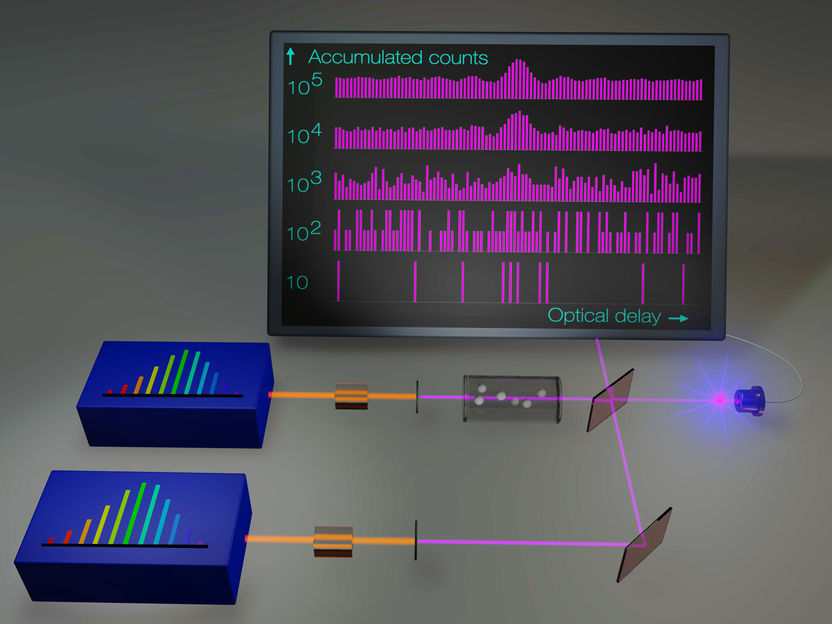In a recent publication in the journal Nature, researchers from the Max Born Institute (MBI) in Berlin, Germany, and the Max-Planck Institute of Quantum Optics in Karching, Germany, report on a new technique for understanding the properties of matter with light, which can detect multiple substances simultaneously and with high chemical selectivity. Measure accurately. Their technique probes atoms and molecules in the ultraviolet region of the spectrum at very weak light levels. Using two optical frequency combs and a photon counter, the experiments open up exciting possibilities for conducting dual-comb spectroscopy at low-light conditions, and they pave the way for new applications of photon-level detectors, such as precision spectroscopy of single atoms or molecules. Fundamental experiments of physics and ultraviolet photochemistry in the Earth's atmosphere or from space telescopes.

An ultraviolet photon-counting double-comb spectrometer. The two UV frequency combs have slightly different pulse repetition frequencies generated by the non-linear frequency shift of adjacent infrared combs at very low light levels. An ultraviolet comb passes through a sample. Both weak combs are superimposed by a beam splitter and detected by a photon-counting detector. At power levels a million times weaker than normally used, the statistics of the detected photons carry information about the sample with its highly complex optical spectrum.
TW Hänsch (MPI for Quantum Optics) and N. Picqué (MPI for Quantum Optics, Max Born Institute)
Ultraviolet spectroscopy plays an important role in the study of electronic transitions in atoms and rovibronic transitions in molecules. These probes are essential for fundamental physics, quantum-electrodynamics theory, determination of fundamental constants, precision measurements, optical clocks, atmospheric chemistry and astrophysics, and high-resolution spectroscopic experiments in support of strong-field physics. Scientists in Nathalie Picqué's group have made significant progress in the field of UV spectroscopy by successfully implementing high-resolution linear-absorption double-comb spectroscopy in the UV spectral range. This groundbreaking achievement opens up new possibilities for performing low-light experiments and paves the way for innovative applications in various scientific and technological fields.
Double-comb spectroscopy, a powerful technique for accurate spectroscopy over wide spectral bands, is mainly used for infrared linear absorption of small molecules in the gas phase. It relies on measuring the time-dependent interference between two frequency combs. A frequency comb is a spectrum of evenly spaced, phase-coherent laser lines that act like a ruler to measure the frequency of light with extreme precision. The dual-comb technique does not suffer from the geometric limitations associated with traditional spectroscopic measurements, and offers excellent potential for high accuracy and precision.
However, double-comb spectroscopy typically requires intense laser beams, making it less suitable for scenarios where low light levels are critical. The team has now experimentally demonstrated that double-comb spectroscopy can be effectively used in starved-light conditions, at power levels a million times weaker than those normally used. This breakthrough was achieved using two distinct experimental setups with different types of frequency-comb generators. The team developed a photon-level interferometer that accurately records photon count statistics, showing a signal-to-noise ratio in the fundamental range. This achievement highlights the optimal use of available light for experiments, and opens up the possibility of dual-comb spectroscopy in challenging situations where low light levels are necessary.
The researchers addressed the challenges associated with developing UV frequency combs and dual-comb interferometers with long synchronization times, paving the way for advances in this desirable goal. They finely controlled the mutual synchronization of two comb lasers with one femtowatt per comb line, demonstrating optimal generation of counting statistics of their interference signal over an hour. „Our innovative approach to low-light interferometry overcomes the challenges caused by the low efficiency of nonlinear frequency conversion, and lays a solid foundation for extending dual-comb spectroscopy to even shorter wavelengths.”, comments Pingxin Xu, postdoctoral scientist. Conducted experiments.
Indeed, a compelling future application is the development of double-comb spectroscopy at short wavelengths, enabling accurate vacuum and extreme-UV molecular spectroscopy over a wide spectral range. Currently, broadband extreme-UV spectroscopy is limited in resolution and accuracy, and relies on unique instruments in specialized facilities. « Ultraviolet double-comb spectroscopy, although a challenging goal, has now become a realistic one as a result of our research. Importantly, our results extend the full capabilities of dual-comb spectroscopy to low-light conditions, opening novel applications in precision spectroscopy, biomedical sensing, and environmental atmospheric acoustics. On a more personal note, this milestone was the result of an experiment at the Max-Planck Institute of Quantum Optics, and I was already my director at the Max Born Institute. I can't imagine a more wonderful way to transition to a new institution. MBI will now conduct our next exciting tests in this field! », concludes Nathalie Picqué. The development of double-comb spectroscopy in the narrow wavelength range promises advances in many scientific and technological fields, underscoring the importance of this achievement.

„Oddany rozwiązywacz problemów. Przyjazny hipsterom praktykant bekonu. Miłośnik kawy. Nieuleczalny introwertyk. Student.
